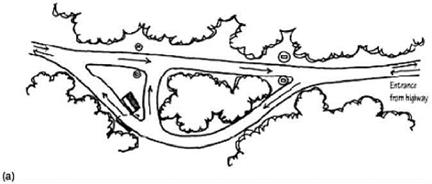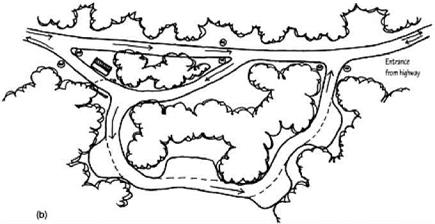After having driven, often for long distances and perhaps in heavy traffic and stressful conditions, it takes a little time to adjust to the ambience of the outdoors. The adjustment can be aided by a stretch of road between the entrance and the first stopping point, such as a car park or scenic turnout, which helps the car occupants to relax a little, absorb the scenery and become used to the possible presence of wildlife near or on the road, walkers crossing or small children playing. The length need not be very long if space does not allow it, but even a short wind down can be very useful.
As well as benefiting the car occupants, the wind-down also helps to ensure that there is adequate physical separation between the main car parking area and the public highway. In Europe, where traffic is heavy, getting away from noise, pollution and physical danger to children and pets is an important issue. Noise may be difficult to avoid unless landform can be used to absorb it, but physical separation should be as great as is feasible. Even in remoter, quieter landscapes the drive down a winding lane from the highway can increase anticipation and the sense of mystery, as well as helping to slow vehicles down.
|
|
|
|
Two layouts for entrances with pay-stations. These show arrangements for the British, Australian or New Zealand driving side: reverse them for North America, Continental Europe etc. (a) In this example a loop allows people to leave before they pass the pay-station in case they decide that fees are unacceptable. The entrance can be closed while one-way flow control allows for people to leave after the entrance has closed. (b) Some parking for limited use is worth providing for local, frequent users or during the low season, when the main site is closed: shown here as a short loop off the entrance area.
The slower travelling speed can be achieved with a narrower road width, rougher surface and tighter curves, as well as speed limit signs. Glimpses of scenery along the road (see ‘Roadside landscape design’ above) can also be used to increase anticipation and reduce speed.





